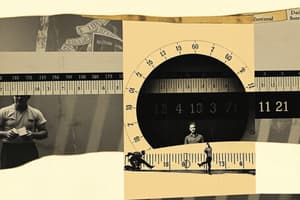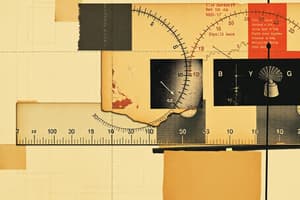Podcast
Questions and Answers
Flashcards
What is a unit in measurements?
What is a unit in measurements?
A label used to identify a property being measured, is essential for any measurement, and is very case-sensitive, meaning capital letters are important.
How does the Metric System work?
How does the Metric System work?
The Metric System uses prefixes to increase or decrease the size of base units by factors of 10. They are written before the base unit (e.g., kg for kilogram, which is 1000 grams).
How to convert between metric units?
How to convert between metric units?
The relationship between two metric units of the same property can be determined using the prefix's numerical value. For example, 1 kg = 103 g.
What is Length?
What is Length?
Signup and view all the flashcards
What is Mass?
What is Mass?
Signup and view all the flashcards
What is Volume?
What is Volume?
Signup and view all the flashcards
What is Dimensional Analysis?
What is Dimensional Analysis?
Signup and view all the flashcards
What is Density?
What is Density?
Signup and view all the flashcards
Study Notes
Unit Systems and Dimensional Analysis
- The metric system uses units for length, mass, and volume.
- Units are crucial in mathematical operations.
- Conversion factors are used to change units.
- Dimensional analysis is a technique to convert units.
- Density is a measure of mass per unit volume.
- Temperature units include Celsius (°C), Kelvin (K), and Fahrenheit (°F).
Units in Measurements
- A unit labels a measured property.
- Measurements must include a unit.
- Units are case-sensitive (e.g., g ≠ G; m ≠ M).
- Systems of units include the metric system and the English system.
Metric System
- Prefixes modify base units by factors of 10.
- Prefixes are written before the base unit.
- Examples of prefixes and their numerical values:
- mega (M) = 1,000,000 (106)
- kilo (k) = 1,000 (103)
- centi (c) = 0.01 (10-2)
- milli (m) = 0.001 (10-3)
- micro (µ) = 0.000001 (10-6)
- nano (n) = 0.000000001 (10-9)
Using the Metric System
- To convert between metric units, use the powers of 10 associated with the prefixes.
- For example, 1 kilogram (kg) equals 103 grams (g).
Length
- The base unit in the metric system for length is the meter (m).
- Conversion examples:
- 1 meter (m) = ? kilometers (km)
- 1 centimeter (cm) = ? meters (m)
- 1 micrometer (µm) = ? meters (m)
- English system units for length include inches (in), feet (ft), yards (yd), and miles (mi). Conversions exist between these units and the metric system.
Mass
- The base unit in the metric system for mass is the gram (g).
- Conversion examples:
- 1 gram (g) = ? milligrams (mg)
- 1 gram (g) = ? kilograms (kg)
- Other English units of mass, such as ounces (oz) and pounds (lb), are also used.
Volume
- The base metric unit for volume is the liter (L).
- 1 liter (L) is the volume of a cube with 10-centimeter sides.
- 1 liter (L) = 1000 milliliters (mL) = 1000 cubic centimeters (cm³).
- English units for volume include quarts (qt) and gallons (gal), and their relationship to metric units.
Time
- The base unit for time is the second (s).
Temperature
- Metric units for temperature include degrees Celsius (°C) and Kelvin (K).
- English units for temperature include degrees Fahrenheit (°F).
- Conversion formulas exist between these scales.
Units in Mathematical Operations
- Units can be treated like algebraic variables when combining in equations.
- Examples demonstrate how units combine in mathematical computations (e.g., g x g x cm = g2cm).
Studying That Suits You
Use AI to generate personalized quizzes and flashcards to suit your learning preferences.




